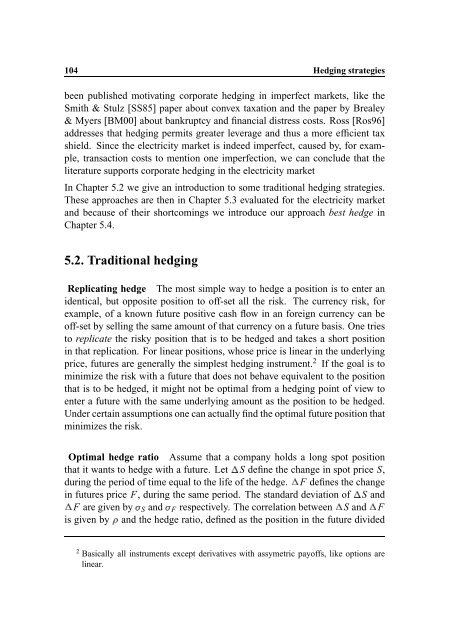Hedging Strategy and Electricity Contract Engineering - IFOR
Hedging Strategy and Electricity Contract Engineering - IFOR
Hedging Strategy and Electricity Contract Engineering - IFOR
Create successful ePaper yourself
Turn your PDF publications into a flip-book with our unique Google optimized e-Paper software.
104 <strong>Hedging</strong> strategies<br />
been published motivating corporate hedging in imperfect markets, like the<br />
Smith & Stulz [SS85] paper about convex taxation <strong>and</strong> the paper by Brealey<br />
& Myers [BM00] about bankruptcy <strong>and</strong> financial distress costs. Ross [Ros96]<br />
addresses that hedging permits greater leverage <strong>and</strong> thus a more efficient tax<br />
shield. Since the electricity market is indeed imperfect, caused by, for example,<br />
transaction costs to mention one imperfection, we can conclude that the<br />
literature supports corporate hedging in the electricity market<br />
In Chapter 5.2 we give an introduction to some traditional hedging strategies.<br />
These approaches are then in Chapter 5.3 evaluated for the electricity market<br />
<strong>and</strong> because of their shortcomings we introduce our approach best hedge in<br />
Chapter 5.4.<br />
5.2. Traditional hedging<br />
Replicating hedge The most simple way to hedge a position is to enter an<br />
identical, but opposite position to off-set all the risk. The currency risk, for<br />
example, of a known future positive cash flow in an foreign currency can be<br />
off-set by selling the same amount of that currency on a future basis. One tries<br />
to replicate the risky position that is to be hedged <strong>and</strong> takes a short position<br />
in that replication. For linear positions, whose price is linear in the underlying<br />
price, futures are generally the simplest hedging instrument. 2 If the goal is to<br />
minimize the risk with a future that does not behave equivalent to the position<br />
that is to be hedged, it might not be optimal from a hedging point of view to<br />
enter a future with the same underlying amount as the position to be hedged.<br />
Under certain assumptions one can actually find the optimal future position that<br />
minimizes the risk.<br />
Optimal hedge ratio Assume that a company holds a long spot position<br />
that it wants to hedge with a future. Å Let S define the change in spot price S,<br />
during the period of time equal to the life of the Å hedge. F defines the change<br />
in futures price F, during the same period. The st<strong>and</strong>ard deviation Å of S <strong>and</strong><br />
F are given by Æ S <strong>and</strong> Æ F respectively. The correlation between Å S <strong>and</strong> Å F<br />
Å<br />
is given Ç by <strong>and</strong> the hedge ratio, defined as the position in the future divided<br />
2 Basically all instruments except derivatives with assymetric payoffs, like options are<br />
linear.
















